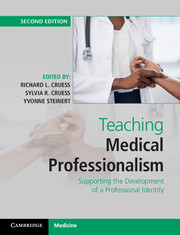Book contents
- Frontmatter
- Contents
- List of contributors
- Foreword
- Introduction
- Part I What is to be taught and learned
- Part II Theory
- Part III Principles
- 8 General principles for establishing programs to support professionalism and professional identity formation at the undergraduate and postgraduate levels
- 9 Faculty development to support professionalism and professional identity formation
- 10 Becoming interprofessional: professional identity formation in the health professions
- 11 Assessment of professionalism and progress in the development of a professional identity
- 12 Remediation of unprofessional behavior
- 13 Professional identity formation, the practicing physician, and continuing professional development
- 14 Professionalism, professional identity, and licensing and accrediting bodies
- Part IV Case studies in promoting professionalism and professional identity formation across the continuum
- Part V The future
- Index
- References
14 - Professionalism, professional identity, and licensing and accrediting bodies
from Part III - Principles
Published online by Cambridge University Press: 05 April 2016
- Frontmatter
- Contents
- List of contributors
- Foreword
- Introduction
- Part I What is to be taught and learned
- Part II Theory
- Part III Principles
- 8 General principles for establishing programs to support professionalism and professional identity formation at the undergraduate and postgraduate levels
- 9 Faculty development to support professionalism and professional identity formation
- 10 Becoming interprofessional: professional identity formation in the health professions
- 11 Assessment of professionalism and progress in the development of a professional identity
- 12 Remediation of unprofessional behavior
- 13 Professional identity formation, the practicing physician, and continuing professional development
- 14 Professionalism, professional identity, and licensing and accrediting bodies
- Part IV Case studies in promoting professionalism and professional identity formation across the continuum
- Part V The future
- Index
- References
Summary
Introduction
Because self-regulation or physician-led regulation is a fundamental aspect of being a professional, it is important that those entering the medical profession understand the nature of this regulation, the organizations within medicine mandated to carry out these functions, and how regulation of the profession relates to them as individuals. For these reasons, material relating to the regulatory processes must be included as a part of educational programs designed to support the development of the identities of future physicians so that they may better understand their roles in the profession and in society. While this chapter emphasizes the current state of regulation in the English-speaking world, the trends outlined are found in most developed countries.
Every patient wants to be sure that they have a “good” doctor. No right-thinking person would knowingly choose a bad doctor or even one who they think is barely adequate. The public expects regulators, educators, and employers to provide them with good doctors, to make sure their doctors stay that way, and to act promptly to protect them when they do not. Professor Ron Paterson, former New Zealand Health and Disability Commissioner, said, “It is generally accepted that the vast majority of doctors are well-intentioned and practice safely. But good intentions and generally adequate care are not enough. As a member of the public, and as a potential patient, I want to know that I can rely on the public medical register as assurance that any listed doctor is competent.”
Medical regulation in its various forms – licensure, certification, and accreditation in particular – is the means through which the state is expected to make sure that the public is indeed served by doctors who are ethical and competent.2 In some countries, the United States and British Commonwealth for example, the state has delegated part of its responsibility to some medical organizations through self-regulation. Self-regulation is thus a privilege, granted by the state, that has to be earned and constantly justified. It is not the right that some doctors think it is.
Medical professionalism has been defined as a set of values, behaviors, and relationships that underpin the public's trust in doctors.
- Type
- Chapter
- Information
- Teaching Medical ProfessionalismSupporting the Development of a Professional Identity, pp. 201 - 216Publisher: Cambridge University PressPrint publication year: 2016
References
- 3
- Cited by



